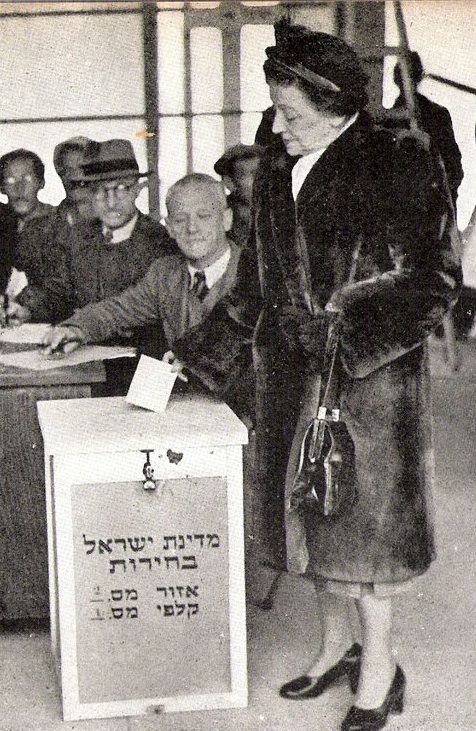Beit Shemesh, Religious Extremism, and the Dignity of Women: Some Lessons from History

Vera Weizmann voting in Israel's first elections
The recent contretemps in Beit Shemesh riveted the Israeli public and brought worldwide attention to the misogynistic treatment accorded women in the public square by certain sectors of ultra-Orthodox Israeli society. As is by now well-known, some ultra-Orthodox Jews there hurled insults and engaged in bullying an eight-year-old Orthodox girl named Naama Margolese for dressing “immodestly” on her way to school. These same Jews also rioted when public street signs situated in an area inhabited by a population of ultra-Orthodox, Orthodox, and secular Jews that instructed women to dress according to their particular standards of modesty were removed. In recent months, ultra-Orthodox sensibilities have also led to the creation of bus routes where women are segregated and consigned to the back of the bus. On some public ceremonial occasions, women have been prohibited from singing lest their voices offend male listeners and on other occasions when women have sung there has been the spectacle of rabbis placing their hands over their ears to block out their sound. These episodes of Jewish religious extremism unconscionably objectify women and are absolutely incompatible with the democratic and egalitarian values upon which the State of Israel was founded.
This is not the first time such conflict between sectors of the ultra-Orthodox community and the other Jewish citizens of the State of Israel has been manifest. Indeed, such clashes predate the State itself. The ways in which secular and especially Orthodox religious leaders spoke out and acted in those cases provide models for how I would hope that present-day Israeli and Jewish religious leaders would respond to the concerns these events in Beth Shemesh and elsewhere evoke.
3 comments on “Beit Shemesh, Religious Extremism, and the Dignity of Women: Some Lessons from History”
Comments are closed.




What an instructive recap of history. Where are Israel’s chief rabbis now? Have they taken a stand on the current outbreak of religious extremism targeting women?
Coming from people who were looked down on because they were jewish and blacks because of their race, and now look down on others because of their sex?! Of course we’re all different – there’s femine men and more masculine women – not because they’re gay. Being with people who are different is uncomfortable at 1st untill we learn to relate to each other and see what we have in common. Learning to live in peace with our differences is what living is about. Try it!
I will tell you where Israel’s chief rabbis are today. At the funeral of former MK Rabbi Hanan Porat, in Kfar Etzion, both chief rabbis were present, Hanan’s daughters (and the rest of the family, but especially the daughters) sang, and the chief rabbis stayed put and nobody put his hands over his ears. I’m sure that’s only one example but it happens to be an event at which, as a journalist, I was literally five feet away from them. Don’t believe everything you read in the papers.